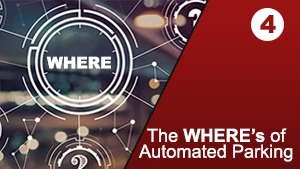
{image_1} When thinking about the uses for automated parking systems (APSs), the first image that often comes to mind is the one of urban traffic congestion where these solutions can help. APSs are increasingly a solution to be able to park the ever-rising number of cars in such a way that space and resources can be saved, regardless of the development type. Throughout this blog we will outline the possibilities where an APS can be installed.
This is the fourth installment of Westfalia´s “Envision APS” blog series – The Where´s of Automated Parking. As we near the end of this series, answering common questions that we are asked in the context of automated parking systems (APS), be sure to refer back to previous topics using the links below. The topics are categorized into who, what, when, where, why and how. If you have questions that we don´t cover in our blog series, click here to send them to us or use #envisionAPS on social media and a member of our team will personally reach out!
Part 1: The WHO's of Automated Parking
Part 2: The WHAT's of Automated Parking
Part 3: The WHEN´s of Automated Parking
Where is automated parking used?
In search of space and land-saving parking solutions, developers are increasingly turning to APSs because these systems are often proven to reduce land, construction and operational costs. In addition to public parking garages, APSs can be found in any type of real estate development such as malls, offices, hotels, airports and residential developments, including mixed use properties combing commercial and residential use. Although cost is often the most important factor for investors, city planners and municipalities are tasked with improving the ever-growing parking problem in a sustainable way for their residents. For example, Copenhagen in Denmark, is aiming to becoming the first city in the world to be CO2-neutral by 2025, has been using APSs for over a decade to vastly reduce emissions and energy consumption. In fact, when looking for a space-efficient, cost-saving and low emission parking solution, APS is the way to go.
Where can an automated parking system be built?
Whether above ground, where the system is aesthetically integrated into the building architecture, or underground, to accommodate the parking solution as discreetly as possible, APSs can be built virtually anywhere. Some vendors, like Westfalia, also have special solutions that are optimally suited for infill developments so that small parcels of land can be used to maximize parking space.
Any construction project may encounter some legal or zoning restrictions, such as height restrictions or depth restrictions due to tunnels, ground water levels, and difficult ground conditions, etc., but this could be an opportunity to use an APS as you’re able to fit up to 60% more parking spaces in an APS compared to a conventional parking garage. Hence, meeting, or even exceeding your parking requirements, despite these possible restrictions is made even possible with an APS.
Where can I see how automated parking works?
If you’re speaking with a vendor about a project, ask the vendor for their references and plans to go see them in operation. It is always recommended to see a system in action and speak with the customer and users about their experiences with the system prior to working with an APS vendor. Reference visits are also an opportunity to understand which solution might best meet your requirements. Although no two systems are the same, it’s a good idea to see a solution servicing a user type similar to your own project, and to gain an overview of the different technologies that can be best applied in your specific case.
You may also want to enquire about how the equipment is tested prior to delivery. At Westfalia, we have a state-of-the-art test and R&D center where you can get all the details of an APS explained and take a look “inside” the system. Additionally, at Westfalia your system will be tested prior to delivery and installation which also gives you the possibility to see the actual system at work. You can find a selection of Westfalia´s projects here.
Where does my car go after I park it?
Once you have answered a series of questions at the user kiosk, the APS collects your car and transports it from the transfer cabin to its designated parking position within the system. Here, your car will be safely stored during the entire duration of the parking process; unless the car needs to be moved to retrieve a car that is parked behind it. However, third parties do not have access to the APS; therefore, the risk of vandalism and theft is reduced to an absolute minimum. Since vehicles are not maneuvered manually within the system, damage to stored vehicles can also be excluded.
Where do I receive my car when I want to leave?
An APS provides the highest form of user comfort. When you are ready to leave in your vehicle, you simply request your car at the user kiosk by either swiping a fob or ticket. The system will then retrieve the car for you and transport it to the transfer cabin. Typically, your car will be positioned in driving direction for maximum comfort. The only thing you have to do is simply hop in your car and be on your way! Read more about how easy the use of an APS is, or watch a video on the safe and easy handling.
